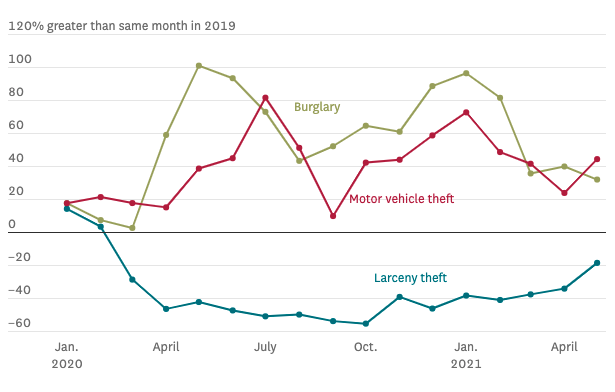
As the number of COVID-19 cases fall in San Francisco, the city is looking a bit more like its pre-pandemic self — and so are its crime rates. A Chronicle analysis of San Francisco crime data shows that rates of four major types of crime that changed drastically during the pandemic are getting closer to their pre-pandemic levels.
We used data from the San Francisco Police Department to compare monthly crime rates during the pandemic with those in 2019, the last full pre-pandemic year. We looked at two types of violent crime, aggravated assaults and robberies, and three types of property crime: burglaries, motor vehicle thefts and larceny thefts. We didn’t look at homicides and rapes because they don’t happen often enough to meaningfully compare month to month.
With the exception of motor vehicle thefts, which remain close to their average levels during the pandemic, the crimes we looked at have all inched closer to their 2019 levels. All of the crime types, including motor vehicle thefts, have moved away from their pandemic-era highs and lows in recent months.
“The crimes that we had seen decreases in during the pandemic, we’re seeing some increases in them, and in the crimes that we saw increases in during the pandemic, we’re seeing some decreases,” Magnus Lofstrom, a policy director and senior fellow at the Public Policy Institute of California, told The Chronicle.
Unlike most other major U.S. cities, which saw drop-offs in most property crimes, surges in violent crimes overall and soaring homicide rates in particular, San Francisco saw violent crimes go down overall; while homicides increased compared with 2019, it was a relatively small rise. And while burglaries decreased in most major cities, they spiked in S.F.
As of May 2021, rates of burglaries — the crime that saw the greatest pandemic jump of the five we studied — were 32% above their rates in May 2019. That may sound high, but it’s a smaller increase than any other month after March 2020; since that month, burglaries have been up by 62% on average. Lofstrom said it’s possible that burglaries in San Francisco soared at the height of the pandemic because many San Franciscans left their homes temporarily, and vacant homes are more likely to get burgled. Now that workers are returning to their offices in the city, they’re also coming back to live in the city, leaving relatively fewer opportunities for would-be burglars.
Larceny thefts, meanwhile, were 18% below their May 2019 rates as of May 2021. This crime has been down by 42% on average since the pandemic began, so this means larceny theft rates are creeping upward.
The violent crimes we analyzed, robbery and assault, declined for the first six months or so of the pandemic, until COVID-19 cases began surging nationwide in late October. Both robberies and assaults spiked through late February, though robberies remained below 2019 levels for every month except February 2021, when they reached 11% above where they were pre-pandemic.
As of May 2021, both types of violent crime are hovering slightly below pre-pandemic levels, but above their pandemic-era lows.
That these two crimes are up compared with their lowest rates during the pandemic makes sense, Lofstrom said. “The interaction among other people is a fundamental part of those crimes,” he said. “When we’re limiting those interactions, it’s not surprising that we would see fewer aggravated assaults, that we’re going to see fewer robberies, that we’re going to see fewer larceny (thefts).”
Lofstrom cautioned that it’s still too early to make predictions about what will happen in the coming months to years with crime rates in the city, namely because so many factors influence crime, from population density to economic inequality.
“We don’t know, for example, how commuting and working in the city ... will look, say, in a year or two years,” he said.
Still, he said it’s likely that as San Francisco — and the rest of California — continues to recover from the pandemic, crime rates will start to resemble their pre-pandemic selves again.
“I think broadly we can say (that) as we are slowly returning to life that resembles more of the pre-pandemic life, that crime rates are more likely to return to levels that we saw prior to the pandemic,” Lofstrom said.
Charis Kubrin, a criminologist at UC Irvine, said monthly data on crime rates needs to be treated with caution because so many factors can cause short-term boosts or declines in different types of crime, particularly in individual cities.
But she noted that statewide, rates of most types of crime in California have declined precipitously over the past several decades, despite the state reducing its prison population significantly over the past decade. San Francisco is no exception to this trend: Both robberies and aggravated assaults are down more than 50% since the early 1990s.
“As it turns out, California is doing pretty darn well overall,” Kubrin said. “We are still at near historic lows” despite pandemic-era fluctuations.
Looking forward, however, Kubrin expressed concern about various long-term factors related to the pandemic.
“The pandemic has put a lot of economic pressure on folks, (and we’ve seen) rises in purchases of firearms,” she said. “There are a number of problems on the horizon that make me concerned California can sustain these low crime rates.”
Susie Neilson is a San Francisco Chronicle staff writer. Email: susie.neilson@sfchronicle.com Twitter: @susieneilson
"crime" - Google News
June 12, 2021 at 05:38AM
https://ift.tt/2TpsfgP
San Francisco crime is starting to look more like it did before the pandemic - San Francisco Chronicle
"crime" - Google News
https://ift.tt/37MG37k
https://ift.tt/2VTi5Ee
Bagikan Berita Ini














0 Response to "San Francisco crime is starting to look more like it did before the pandemic - San Francisco Chronicle"
Post a Comment